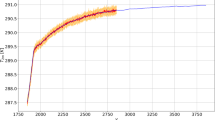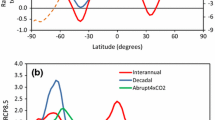Abstract
The sensitivity of climate models to increasing CO2 concentration and the climate response at decadal time-scales are still major factors of uncertainty for the assessment of the long and short term effects of anthropogenic climate change. While the relative slow progress on these issues is partly due to the inherent inaccuracies of numerical climate models, this also hints at the need for stronger theoretical foundations to the problem of studying climate sensitivity and performing climate change predictions with numerical models. Here we demonstrate that it is possible to use Ruelle’s response theory to predict the impact of an arbitrary CO2 forcing scenario on the global surface temperature of a general circulation model. Response theory puts the concept of climate sensitivity on firm theoretical grounds, and addresses rigorously the problem of predictability at different time-scales. Conceptually, these results show that performing climate change experiments with general circulation models is a well defined problem from a physical and mathematical point of view. Practically, these results show that considering one single CO2 forcing scenario is enough to construct operators able to predict the response of climatic observables to any other CO2 forcing scenario, without the need to perform additional numerical simulations. We also introduce a general relationship between climate sensitivity and climate response at different time scales, thus providing an explicit definition of the inertia of the system at different time scales. This technique allows also for studying systematically, for a large variety of forcing scenarios, the time horizon at which the climate change signal (in an ensemble sense) becomes statistically significant. While what we report here refers to the linear response, the general theory allows for treating nonlinear effects as well. These results pave the way for redesigning and interpreting climate change experiments from a radically new perspective.






Similar content being viewed by others
References
Abramov RV, Majda A (2008) New approximations and tests of linear fluctuation-response for chaotic nonlinear forced-dissipative dynamical systems. J Nonlinear Sci 18:303–341
Allen MR, Frame DJ (2007) Call off the quest. Science 318:582–583
Bracegirdle TJ, Stephenson BD (2013) On the robustness of emergent constraints used in multimodel climate change projections of arctic warming. J Clim 26:669–678
Chekroun MD, Simonnet E, Ghil M (2011a) Stochastic climate dynamics: random attractors and time-dependent invariant measures. Phys D 240:1685–1700
Chekroun MD, Kondrashov D, Ghil M (2011b) Predicting stochastic systems by noise sampling, and application to the El Nino-Southern Oscillation. Proc Natl Acad Sci USA 108:11766–11771
Colangeli M, Lucarini V (2014) Elements of a unified framework for response formulae. J Stat Mech P01002. doi:10.1088/1742-5468/2014/01/P01002
Cooper FC, Haynes PH (2011) Climate sensitivity via a nonparametric fluctuation-dissipation theorem. J Atmos Sci 68:937–953
Cooper FC, Esler JG, Haynes PH (2013) Estimation of the local response to a forcing in a high dimensional system using the fluctuation-dissipation theorem. Nonlinear Process Geophys 20:239–248
Cox PM, Pearson D, Booth BB, Friedlingstein P, Huntingford C, Jones CD, Luke CM (2013) Sensitivity of tropical carbon to climate change constrained by carbon dioxide variability. Nature 494:341–344
Fraedrich K, Kirk E, Lunkeit FP (1998) Portable university model of the atmosphere. Technical Report 16, Deutsches Klimarechenzentrum
Fraedrich K, Jansen H, Luksch U, Lunkeit F (2005) The planet simulator: towards a user friendly model. Meteorol Z 14:299–304
Gallavotti G (1996) Chaotic hypotesis: onsanger reciprocity and fluctuation-dissipation theorem. J Stat Phys 84:899–926
Galloway J, Heimann J, Le Quéré C, Levitus S, Ramaswamy V (2013) Climate sensitivity in the Anthropocene. Q J R Meteorol Soc 139:1121–1131
Gritsun A, Branstator G (2007) Climate response using a three-dimensional operator based on the Fluctuation Dissipation theorem. J Atmos Sci 64:2558–2575
Hasselmann K, Sausen R, Maier-Reimer E, Reinhard V (1993) On the cold start problem in transient simulations with coupled atmosphere ocean models. Clim Dyn 9:53–61
Held IM, Soden BJ (2006) Robust responses of the hydrological cycle to global warming. J Clim 19:5686–5699
IPCC (2007a) In: Parry ML, Canziani OF, Palutikof JP, van der Linden PJ, Hanson CE (eds) Climate Change 2007: Impacts, adaptation and vulnerability. Contribution of Working Group II to the Fourth Assessment Report of the Intergovernmental Panel on Climate Change. Cambridge University Press, Cambridge, UK
IPCC (2007b) In: Solomon S, Qin D, Manning M, Chen Z, Marquis M, Averyt KB, Tignor M, Miller HL (eds) Climate change 2007: the physical science basis. Contribution of Working Group I to the Fourth Assessment Report of the Intergovernmental Panel on Climate Change. Cambridge University Press, Cambridge, United Kingdom and New York, NY, USA
IPCC (2013) In: Stocker TF, Qin D, Plattner G-K, Tignor M, Allen SK, Boschung J, Nauels A, Xia Y, Bex V, Midgley PM (eds) Climate Change 2013: the physical science basis. Contribution of working group I to the fifth assessment report of the intergovernmental panel on climate change stocker. Cambridge University Press, Cambridge, United Kingdom and New York, NY, USA
Kalnay E (2003) Atmospheric modeling, data assimilation and predictability. Cambridge University Press, Cambridge
Knutti R, Hegerl GC (2008) The equilibrium sensitivity of the Earth’s temperature to radiation changes. Nat Geosci 1:735–743
Kubo R (1966) The fluctuation-dissipation theorem. Rep Prog Phys 29:255–284
Langen PL, Alexeev VA (2005) Estimating 2 × CO2 warming in an aquaplanet GCM using the fluctuation-dissipation theorem. Geophys Res Lett 32(23):L23708
Lorenz E (1979) Forced and free variations of weather and climate. J Atmos Sci 36:1367–1376
Lovejoy S (2014) Scaling fluctuation analysis and statistical hypotesis of anthtropogenic warming. Clim Dyn 42:2339–2351
Lucarini V, Saarinen JJ, Peiponen K-E, Vartiainen EM (2005) Kramers-kronig relations in optical materials research. Springer, Heidelberg
Lucarini V (2008) Response theory for equilibrium and non-equilibium statistical mechanics: causality and generalized Kramers–Kronig relations. J Stat Phys 131:543–558
Lucarini V (2009) Evidence of dispersion relations for the nonlinear response of Lorenz 63 System. J Stat Phys 134:381–400
Lucarini V, Sarno S (2011) A statistical mechanical approach for the computation of the climatic response to general forcings. Nonlin Processes Geophys 18:7–28
Lucarini V, Colangeli M (2012) Beyond the linear fluctuation-dissipation theorem: the role of causality. J Stat Mech P05013. doi:10.1088/1742-5468/2012/05/P05013
Lucarini V, Blender R, Herbert C, Pascale S, Ragone F, Wouters J (2014) Mathematical and physical ideas for climate science. http://arxiv.org/abs/1311.1190
Lunt DJ, Haywood AM, Schmidt GA, Salzmann U, Valdes PJ, Dowset HJ (2010) Earth system sensitivity inferred from Pliocene modelling and data. Nat Geosci 3:60–64
Nicolson AM (1973) Forming the fast Fourier transform of a step response in time-domain metrology. Electron Lett 9:317–318
Otto A et al (2013) Energy budget constraints on climate response. Nat Geosci 6:415–416
Penland C (1996) A stochastic model of IndoPacific sea surface temperature anomalies. Phys D 98:534–558
Penland C (2003) Noise out of chaos and why it won’t go away. B Am Meteor Soc 84:921–925
Previdi M, Liepert BG, Peteet D, Hansen J, Beerling DJ, Broccoli AJ, Frolking S, Galloway JN, Heimann M, Le Quéré C, Levitus S, Ramaswamy V (2013) Climate sensitivity in the Anthropocene. Q J R Meteorol Soc 139:1121–1131
Ruelle D (1998a) General linear response formula in statistical mechanics, and the fluctuation-dissipation theorem far from equilibrium. Phys Lett A 245:220–224
Ruelle D (1998b) Nonequilibrium statistical mechanics near equilibrium: computing higher-order terms. Nonlinearity 11:5–18
Ruelle D (2009) A review of linear response theory for general differentiable dynamical systems. Nonlinearity 22:855–870
Saltzman B (2001) Dynamical paleoclimatology. Academic Press, New York
Sardeshmukh P, Compo GP, Penland C (2000) Changes in probability assoicated with El Nino. J Clim 13:4268–4286
Sherwood SC, Bony S, Dufresne J-L (2014) Spread in model climate sensitivity traced to atmospheric convective mixing. Nature 505:37–42
Shukla J, Hagedorn R, Hoskins B, Kinter J, Marotzke J, Miller M, Palmer T, Slingo J (2009) Revolution in climate prediction is both necessary and possible: a declaration at the world modelling summit for climate prediction. B Am Meteor Soc 90:175–178
Stein U, Alpert P (1993) Factor separation in numerical simulations. J Atmos Sci 50:2107–2115
Winton M, Takahashi K, Held IM (2010) Importance of ocean heat uptake efficacy to transient climate change. J Clim 23:2333–2344
Wouters J, Lucarini V (2013) Multi-level dynamicsl systems: connecting the Ruelle response theory and the Mori-Zwanzig approach. J Stat Phys 151:850–860
Acknowledgments
The authors wish to thank C. Franzke and G. Gallavotti for commenting on an earlier version of the manuscript. F.R. wish to thank T. Bodai and S. Schubert for useful discussions. F.R. and V.L. acknowledge funding from the Cluster of Excellence for Integrated Climate Science (CLISAP) and from the European Research Council under the European Community’s Seventh Framework Programme (FP7/2007-2013)/ERC Grant agreement No. 257106. The authors acknowledge the Newton Institute for Mathematical Sciences (Cambridge, UK), hosting the 2013 programme “Mathematics for the Fluid Earth” during which part of this work was discussed.
Author information
Authors and Affiliations
Corresponding author
Rights and permissions
About this article
Cite this article
Ragone, F., Lucarini, V. & Lunkeit, F. A new framework for climate sensitivity and prediction: a modelling perspective. Clim Dyn 46, 1459–1471 (2016). https://doi.org/10.1007/s00382-015-2657-3
Received:
Accepted:
Published:
Issue Date:
DOI: https://doi.org/10.1007/s00382-015-2657-3




